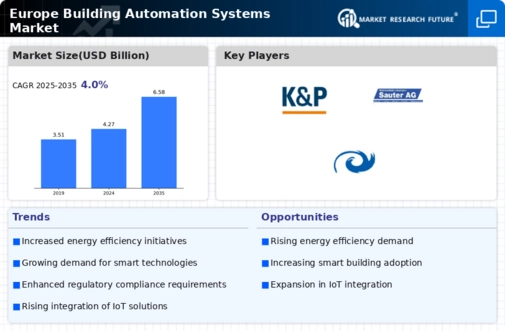The Europe Building Automation Systems Market is characterized by a dynamic competitive landscape, driven by increasing demand for energy efficiency, sustainability, and enhanced user experience in building management. Key players such as Siemens (DE), Schneider Electric (FR), and Johnson Controls (IE) are at the forefront, each adopting distinct strategies to solidify their market positions. Siemens (DE) emphasizes innovation through its digital twin technology, which enhances operational efficiency and predictive maintenance. Schneider Electric (FR) focuses on sustainability, integrating renewable energy solutions into its building automation systems, thereby appealing to environmentally conscious consumers. Johnson Controls (IE) leverages its extensive experience in HVAC systems to offer comprehensive building management solutions, positioning itself as a leader in smart building technologies. Collectively, these strategies foster a competitive environment that prioritizes technological advancement and sustainability.
In terms of business tactics, companies are increasingly localizing manufacturing to reduce lead times and enhance supply chain resilience. This approach is particularly relevant in the context of geopolitical uncertainties and fluctuating global supply chains. The market structure appears moderately fragmented, with several players vying for market share, yet the influence of major companies remains substantial. Their ability to innovate and adapt to changing market demands significantly shapes the competitive dynamics within the sector.
In August 2025, Siemens (DE) announced the launch of its new cloud-based building management platform, which integrates AI-driven analytics to optimize energy consumption in real-time. This strategic move not only enhances Siemens' product offerings but also positions the company as a pioneer in the integration of artificial intelligence within building automation. The platform's capabilities are expected to attract a diverse clientele, from commercial real estate to industrial sectors, thereby expanding Siemens' market reach.
In September 2025, Schneider Electric (FR) unveiled its partnership with a leading renewable energy provider to develop smart grid solutions that enhance energy management in buildings. This collaboration underscores Schneider's commitment to sustainability and positions it to capitalize on the growing trend of energy-efficient building solutions. By aligning with renewable energy initiatives, Schneider Electric is likely to strengthen its brand reputation and appeal to a broader customer base focused on sustainability.
In October 2025, Johnson Controls (IE) launched a new initiative aimed at integrating IoT technologies into its existing building management systems. This initiative is expected to enhance operational efficiency and provide clients with actionable insights through advanced data analytics. By embracing IoT, Johnson Controls is not only modernizing its offerings but also responding to the increasing demand for smart building solutions that leverage connectivity and data.
As of October 2025, the competitive trends within the Europe Building Automation Systems Market are increasingly defined by digitalization, sustainability, and the integration of artificial intelligence. Strategic alliances, such as those seen with Schneider Electric, are shaping the landscape by fostering innovation and expanding market capabilities. Looking ahead, it appears that competitive differentiation will increasingly pivot from traditional price-based competition to a focus on innovation, technological advancement, and supply chain reliability, as companies strive to meet the evolving demands of the market.
















Leave a Comment